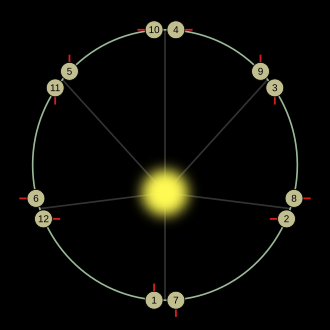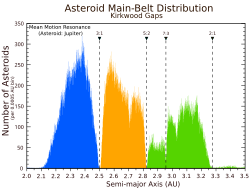Orbital resonance
Orbital resonance is a resonance of two orbiting bodies exerting a regular, periodic gravitational effect on each other. Their orbital periods may be related by a ratio of two small integers. It is caused by the changing gravitational forces of bodies which go round each other. The stability of the Solar System was first investigated by Laplace, and there is still much that is not known about it.[1]
As a satellite goes round a planet or two stars go round each other, the gravitational forces can change, sometimes hugely. This is partly because orbits are usually ellipses, not circular, and so the forces change accordingly. Also, the planets and stars are usually not spherical. They spin, and vary in their degree of oblateness. This also changes the forces on an orbiting body.
In particular, the forces may be unstable, so the smaller partner may change until the forces are stable (do not change with time).[2] Satellites often end up with one face towards their planet, because that is the most stable position (tidal locking).
There are other stability effects. Gaps in Saturn's rings are caused by the particles shifting into more stable positions. In the rings of Saturn, the Cassini Division is a gap between the inner B Ring and the outer A Ring. It was cleared by a 2:1 resonance with the moon Mimas. Jupiter makes similar Kirkwood gaps in the asteroid belt.
There is a stability ratio for Neptune and Pluto: the 2:3 ratio means Pluto completes two orbits in the time it takes Neptune to complete three.[3]
The area of mechanics which is used for these studies is called celestial mechanics.
Orbital Resonance Media
The three-body Laplace resonance exhibited by three of Jupiter's Galilean moons. Conjunctions are highlighted by brief color changes. There are two Io-Europa conjunctions (green) and three Io-Ganymede conjunctions (grey) for each Europa-Ganymede conjunction (magenta). This diagram is not to scale.
The semimajor axes of resonant trans-Neptunian objects (red) are clumped at locations of low-integer resonances with Neptune (vertical red bars near top), in contrast to those of cubewanos (blue) and nonresonant (or not known to be resonant) scattered objects (grey).
A chart of the distribution of asteroid semimajor axes, showing the Kirkwood gaps where orbits are destabilized by resonances with Jupiter
Spiral density waves in Saturn's A Ring excited by resonances with inner moons. Such waves propagate away from the planet (towards upper left). The large set of waves just below center is due to the 6:5 resonance with Janus.
The eccentric Titan Ringlet just inside it have apsidal and nodal precessions, respectively, commensurate with Titan's mean motion.
Depiction of Haumea's presumed 7:12 resonance with Neptune in a rotating frame, with Neptune (blue dot at lower right) held stationary. Haumea's shifting orbital alignment relative to Neptune periodically reverses (librates), preserving the resonance.
Depiction of asteroid Pallas's 18:7 near resonance with Jupiter in a rotating frame (click for animation). Jupiter (pink loop at upper left) is held nearly stationary. The shift in Pallas's orbital alignment relative to Jupiter increases steadily over time; it never reverses course (i.e., there is no libration).
References
- ↑ Murray C.D. & Dermott S.F. 1999. Solar System dynamics. Cambridge University Press. ISBN 0-521-57597-4.
- ↑ Malhotra, Renu 1998. Orbital resonances and chaos in the Solar System. In Solar System formation and evolution, ASP Conference Series. 149. preprint Archived 2013-12-11 at the Wayback Machine.
- ↑ Malhotra, Renu 1995. The origin of Pluto's orbit: implications for the Solar System beyond Neptune. The Astronomical Journal, 110, p. 420 preprint.










